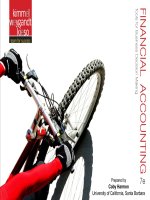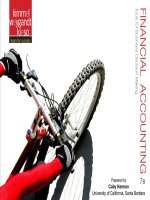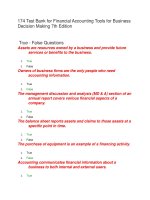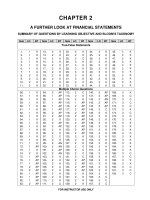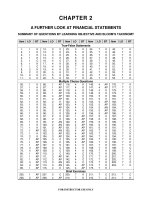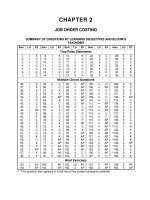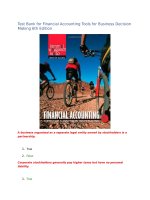Financial accounting tools for business decision making 8th edition solutions manual kimmel
Bạn đang xem bản rút gọn của tài liệu. Xem và tải ngay bản đầy đủ của tài liệu tại đây (733.74 KB, 51 trang )
Financial Accounting Tools for Business Decision Making 8th Edition
Solutions Manual Kimmel Weygandt Kieso
CHAPTER 2
A Further Look at Financial Statements
Learning Objectives
1.
2.
3.
Identify the sections of a classified balance sheet.
Use ratios to evaluate a company’s profitability, liquidity, and solvency.
Discuss financial reporting concepts.
Summary of Questions by Learning Objectives and Bloom’s Taxonomy
Item
1.
2.
3.
4.
LO
1
1
1
1
BT
K
K
C
C
Item
5.
6.
7.
8.
LO
1
2
2
2
BT
K
C
K
C
Item
LO
BT
Questions
9.
2
C
10.
2
K
11.
2
C
12.
3
K
Item
LO
BT
Item
LO
BT
13.
14.
15.
16.
3
3
3
3
K
C
C
C
17.
18.
19.
20.
3
3
3
1
C
C
C
C
7.
8.
3
3
K
K
9.
10.
3
3
K
K
3.
3
K
10.
11.
2
2
AP
AP
12.
13.
3
3
K
C
7.
8.
2
3
AP
E
Brief Exercises
1.
2.
1
1
K
AP
3.
4.
2
2
AP
AP
1a.
1
AP
1b.
1
AP
5.
2
AP
6.
3
K
Do It! Exercises
2.
2
AP
Exercises
1.
2.
3.
1
1
1
AP
AP
AP
4.
5.
6.
1
1
1
AP
AP
AP
7.
8.
9.
2
1, 2
2
AP
AP
AP
Problems: Set A
1.
2.
1
1
AP
AP
3.
4.
1
2
AP
AN
Kimmel, Financial Accounting, 8/e, Solutions Manual
5.
6.
2
2
AP
AP
(For Instructor Use Only)
2-1
ASSIGNMENT CHARACTERISTICS TABLE
Problem
Number
2-2
Description
Difficulty
Level
Time
Allotted (min.)
Simple
10–20
1A
Prepare a classified balance sheet.
2A
Prepare financial statements.
Moderate
20–30
3A
Prepare financial statements.
Moderate
20–30
4A
Compute ratios; comment on relative profitability,
liquidity, and solvency.
Moderate
20–30
5A
Compute and interpret liquidity, solvency, and profitability
ratios.
Simple
10–20
6A
Compute and interpret liquidity, solvency, and profitability ratios.
Moderate
15–25
7A
Compute ratios and compare liquidity, solvency, and
profitability for two companies.
Moderate
15–25
8A
Comment on the objectives and qualitative characteristics
of financial reporting.
Simple
10–20
Kimmel, Financial Accounting, 8/e, Solutions Manual
(For Instructor Use Only)
ANSWERS TO QUESTIONS
1.
A company’s operating cycle is the average time that is required to go from cash to cash in producing revenue.
LO 1 BT: K Diff: E TOT: 1 min. AACSB: None AICPA FC: Measurement
2.
Current assets are assets that a company expects to convert to cash or use up within one year of
the balance sheet date or the company’s operating cycle, whichever is longer. Current assets are
listed in the order in which they are expected to be converted into cash.
LO 1 BT: K Diff: E TOT: 1 min. AACSB: None AICPA FC: Reporting
3.
Long-term investments are investments in stocks and bonds of other companies where the
conversion into cash is not expected within one year or the operating cycle, whichever is longer
and plant assets not currently in operational use. Property, plant, and equipment are tangible
resources of a relatively permanent nature that are being used in the business and not intended
for sale.
LO 1 BT: C Diff: M TOT: 2 min. AACSB: None AICPA FC: Reporting
4.
Current liabilities are obligations that will be paid within the coming year or operating cycle,
whichever is longer. Long-term liabilities are obligations that will be paid after one year.
LO 1 BT: C Diff: M TOT: 1 min. AACSB: None AICPA FC: Reporting
5.
The two parts of stockholders’ equity and the purpose of each are: (1) Common stock is used to
record investments of assets in the business by the owners (stockholders). (2) Retained earnings
is used to record net income retained in the business.
LO 1 BT: K Diff: M TOT: 2 min. AACSB: None AICPA FC: Reporting
6.
(a) Geena is not correct. There are three characteristics: liquidity, profitability, and solvency.
(b) The three parties are not primarily interested in the same characteristics of a company.
Short-term creditors are primarily interested in the liquidity of the company. In contrast,
long-term creditors and stockholders are primarily interested in the profitability and
solvency of the company.
LO 2 BT: C Diff: M TOT: 3 min. AACSB: None AICPA FC: Reporting
7.
(a) Liquidity ratios: Working capital and current ratio.
(b) Solvency ratios: Debt to assets and free cash flow.
(c)
Profitability ratio: Earnings per share.
LO 2 BT: K Diff: E TOT: 2 min. AACSB: None AICPA FC: Reporting
Kimmel, Financial Accounting, 8/e, Solutions Manual
(For Instructor Use Only)
2-3
8.
Debt financing is riskier than equity financing because debt must be repaid at specific points in
time, whether the company is performing well or not. Thus, the higher the percentage of assets
financed by debt, the riskier the company.
LO 2 BT: C Diff: E TOT: 2 min. AACSB: None AICPA FC: Reporting
9.
(a) Liquidity ratios measure the short-term ability of the company to pay its maturing obligations
and to meet unexpected needs for cash.
(b) Profitability ratios measure the income or operating success of a company for a given period
of time.
(c)
Solvency ratios measure the company’s ability to survive over a long period of time.
LO 2 BT: K Diff: E TOT: 2 min. AACSB: None AICPA FC: Reporting
10.
(a) The increase in earnings per share is good news because it means that profitability has improved.
(b) An increase in the current ratio signals good news because the company improved its ability
to meet maturing short-term obligations.
(c)
The increase in the debt to assets ratio is bad news because it means that the company has
increased its obligations to creditors and has lowered its equity “buffer.”
(d) A decrease in free cash flow is bad news because it means that the company has become
less solvent. The higher the free cash flow, the more solvent the company.
LO 2 BT: AN Diff: M TOT: 3 min. AACSB: Analytic AICPA FC: Reporting
11.
(a) The debt to assets ratio and free cash flow indicate the company’s ability to repay the face
value of the debt at maturity and make periodic interest payments.
(b) The current ratio and working capital indicate a company’s liquidity and short-term debtpaying ability.
(c)
Earnings per share indicates the earning power (profitability) of an investment.
LO 2 BT: C Diff: M TOT: 3 min. AACSB: Analytic AICPA FC: Reporting
12.
(a) Generally accepted accounting principles (GAAP) are a set of rules and practices, having
substantial support, that are recognized as a general guide for financial reporting purposes.
(b) The body that provides authoritative support for GAAP is the Financial Accounting Standards
Board (FASB).
LO 3 BT: K Diff: E TOT: 2 min. AACSB: None AICPA FC: Measurement
13.
(a) The primary objective of financial reporting is to provide information useful for decision making.
(b) The fundamental qualitative characteristics are relevance and faithful representation. The
enhancing qualities are comparability, consistency, verifiability, timeliness, and
understandability.
2-4
Kimmel, Financial Accounting, 8/e, Solutions Manual
(For Instructor Use Only)
LO 3 BT: K Diff: M TOT: 2 min. AACSB: None AICPA FC: Measurement
14.
Dietz is correct. Consistency means using the same accounting principles and accounting
methods from period to period within a company. Without consistency in the application of
accounting principles, it is difficult to determine whether a company is better off, worse off, or the
same from period to period.
LO 3 BT: AN Diff: M TOT: 2 min. AACSB: Analytic AICPA FC: Measurement and Reporting
15.
Comparability results when different companies use the same accounting principles. Consistency
means using the same accounting principles and methods from year to year within the same
company.
LO 3 BT: C Diff: E TOT: 1 min. AACSB: None AICPA FC: Measurement
16.
The cost constraint allows accounting standard-setters to weigh the cost that companies will incur
to provide information against the benefit that financial statement users will gain from having the
information available.
LO 3 BT: K Diff: E TOT: 1 min. AACSB: None AICPA FC: Measurement
17.
Accounting standards are not uniform because individual countries have separate standardsetting bodies. Currently many non-U.S. countries are choosing to adopt International Financial
Reporting Standards (IFRS). It appears that accounting standards in the United States will move
toward compliance with IFRS.
LO 3 BT: C Diff: M TOT: 2 min. AACSB: None AICPA FC: Measurement
18.
Accounting relies primarily on two measurement principles. Fair value is sometimes used when
market price information is readily available. However, in many situations reliable market price
information is not available. In these instances, accounting relies on historical cost as its basis.
19.
The economic entity assumption states that every economic entity can be separately identified and
accounted for. This assumption requires that the activities of the entity be kept separate and distinct
from (1) the activities of its owners (the shareholders) and (2) all other economic entities. A
shareholder of a company charging personal living costs as expenses of the company is an
example of a violation of the economic entity assumption.
20.
At September 27, 2014 Apple’s largest current asset was Cash and cash equivalents of $14,557
million, its largest current liability is Accounts payable of $16,459 million and its largest item
under “Assets” was Property and equipment, net of $16,967 million.
Kimmel, Financial Accounting, 8/e, Solutions Manual
(For Instructor Use Only)
2-5
SOLUTIONS TO BRIEF EXERCISES
BRIEF EXERCISE 2-1
CL
CA
PPE
PPE
CA
IA
Accounts payable
Accounts receivable
Accumulated depreciation
Buildings
Cash
Goodwill
CL
LTI
PPE
CA
IA
CA
Income taxes payable
Investment in long-term bonds
Land
Inventory
Patent
Supplies
LO 1 BT: K Difficulty: Easy TOT: 2 min. AACSB: None AICPA FC: Reporting
BRIEF EXERCISE 2-2
CHIN COMPANY
Partial Balance Sheet
Current assets
Cash .........................................................................................
Debt investments ....................................................................
Accounts receivable ...............................................................
Supplies ...................................................................................
Prepaid insurance ...................................................................
Total current assets ........................................................
$10,400
8,200
14,000
3,800
2,600
$39,000
LO 1 BT: AP Difficulty: Medium TOT: 3 min. AACSB: Analytic AICPA FC: Reporting
BRIEF EXERCISE 2-3
Net income — Preferred dividends
Average common shares outstanding
$220 million – $0
=
= $.66 per share
333 million shares
Earnings per share =
LO 2 BT: AP Difficulty: Easy TOT: 2 min. AACSB: Analytic AICPA FC: Reporting
2-6
Kimmel, Financial Accounting, 8/e, Solutions Manual
(For Instructor Use Only)
BRIEF EXERCISE 2-4
Working capital = Current assets – Current liabilities
Current assets
Current liabilities
Working capital
($102,500,000
201,200,000
($ 98,700,000)
Current ratio:
Current assets
$102,500,000
=
Current liabilities
$201,200,000
= .51:1
LO 2 BT: AP Difficulty: Easy TOT: 3 min. AACSB: Analytic AICPA FC: Reporting
BRIEF EXERCISE 2-5
(a) Current ratio
Current assets
Current liabilities
(b) Debt to assets
Total liabilities
Total assets
(c) Free cash flow
(Net cash provided
operating activities –
capital expenditures –
dividends paid)
$262,787
= 0.89:1
$293,625
$376,002
= 85.5%
$439,832
$62,300 – $24,787 – $12,000 = $25,513
LO 2 BT: AP Difficulty: Easy TOT: 3 min. AACSB: Analytic AICPA FC: Reporting
BRIEF EXERCISE 2-6
(a) True.
(b) False.
LO 3 BT: K Difficulty: Easy TOT: 2 min. AACSB: None AICPA FC: Measurement
Kimmel, Financial Accounting, 8/e, Solutions Manual
(For Instructor Use Only)
2-7
BRIEF EXERCISE 2-7
(a)
(b)
(c)
(d)
(e)
(f)
(g)
(h)
Predictive value.
Confirmatory value.
Materiality
Complete.
Free from error.
Comparability.
Verifiability.
Timeliness.
LO 3 BT: K Difficulty: Easy TOT: 3 min. AACSB: None AICPA FC: Measurement
BRIEF EXERCISE 2-8
(a) Relevant.
(b) Faithful representation.
(c) Consistency.
LO 3 BT: K Difficulty: Easy TOT: 2 min. AACSB: None AICPA FC: Measurement
BRIEF EXERCISE 2-9
(a)
(b)
(c)
(d)
1.
2.
3.
4.
Predictive value.
Neutral.
Verifiable.
Timely.
LO 3 BT: K Difficulty: Easy TOT: 2 min. AACSB: None AICPA FC: Measurement
BRIEF EXERCISE 2-10
(c)
LO 3 BT: K Difficulty: Easy TOT: 1 min. AACSB: None AICPA FC: Measurement
2-8
Kimmel, Financial Accounting, 8/e, Solutions Manual
(For Instructor Use Only)
SOLUTIONS TO DO IT! EXERCISES
DO IT! 2-1a
MYLAR CORPORATION
Balance Sheet (partial)
December 31, 2017
Assets
Current assets
Cash ..................................................................
Accounts receivable ........................................
Inventory ...........................................................
Supplies ............................................................
Total current assets ...............................
Property, plant, and equipment
Equipment.........................................................
Less: Accumulated depreciation—
equipment ..............................................
Total assets ..............................................................
$ 13,000
22,000
58,000
7,000
$100,000
180,000
50,000
130,000
$230,000
LO 1 BT: AP Difficulty: Medium TOT: 5 min. AACSB: Analytic AICPA FC: Reporting
DO IT! 2-1b
IA
CL
NA
CL
LTI
CL
Trademarks
Notes payable (current)
Interest revenue
Income taxes payable
Debt investments (long-term)
Unearned sales revenue
CA
PPE
PPE
SE
NA
LTL
Inventory
Accumulated depreciation
Land
Common stock
Advertising expense
Mortgage payable (due in 3 years)
LO 1 BT: AP Difficulty: Easy TOT: 3 min. AACSB: Analytic AICPA FC: Reporting
Kimmel, Financial Accounting, 8/e, Solutions Manual
(For Instructor Use Only)
2-9
DO IT! 2-2
(a)
2017
2016
($80,000 – $6,000) = $1.29
(40,000 + 75,000)/2
($40,000 – $6,000) = $0.97
(30,000 + 40,000)/2
Nguoi’s profitability, as measured by the amount of income available for
each share of common stock, increased by 33 percent (($1.29 –
$0.97)/$0.97) during 2017. Earnings per share should not be compared
across companies because the number of shares issued by companies
varies widely. Thus, we cannot conclude that Nguoi Corporation is
more profitable than Matisse Corporation based on its higher EPS in
2017.
Net Income Preferred Dividends
Average Common Shares Outstanding
(b)
2017
2016
$54,000
= 2.45:1
$22,000
Current ratio
$36,000
= 1.20:1
$30,000
Current assets
Current liabilities
Debt to
assets ratio
$72,000
= 30%
$240,000
$100,000
= 49%
$205,000
Total liabilities
Total assets
The company’s liquidity, as measured by the current ratio improved
from 1.20:1 to 2.45:1. Its solvency also improved, because the debt to
assets ratio declined from 49% to 30%.
(c)
Free cash flow
2017: $90,000 – $6,000 – $3,000 – $27,000 = $54,000
2016: $56,000 – $6,000 – $1,500 – $12,000 = $36,500
The amount of cash generated by the company above its needs for
dividends and capital expenditures increased from $36,500 to $54,000.
LO 1 BT: AP Difficulty: Easy TOT: 3 min. AACSB: Analytic AICPA FC: Reporting
2-10
Kimmel, Financial Accounting, 8/e, Solutions Manual
(For Instructor Use Only)
DO IT! 2-3
1.
2.
3.
4.
5.
6.
7.
8.
9.
10.
11.
12.
Monetary unit assumption
Faithful representation
Economic entity assumption
Cost constraint
Consistency
Historical cost principle
Relevance
Periodicity assumption
Full disclosure principle
Materiality
Going concern assumption
Comparability
LO 2 BT: K Difficulty: Hard TOT: 10 min. AACSB: Analytic AICPA FC: Reporting
Kimmel, Financial Accounting, 8/e, Solutions Manual
(For Instructor Use Only)
2-11
SOLUTIONS TO EXERCISES
EXERCISE 2-1
CL
CA
PPE
PPE
CA
CL
IA
CL
Accounts payable
Accounts receivable
Accumulated depreciation—equip.
Buildings
Cash
Interest payable
Goodwill
Income taxes payable
CA
CA
PPE
LTL
CA
PPE
CA
Inventory
Stock investments
Land (in use)
Mortgage payable
Supplies
Equipment
Prepaid rent
LO 1 BT: AP Difficulty: Easy TOT: 3 min. AACSB: Analytic AICPA FC: Reporting
EXERCISE 2-2
CA Prepaid advertising
PPE Equipment
IA
Trademarks
CL
Salaries and wages payable
CL
Income taxes payable
SE
Retained earnings
CA Accounts receivable
LTI Land (held for future use)
IA
LTL
SE
PPE
Patents
Bonds payable
Common stock
Accumulated
depreciation—equipment
CL Unearned sales revenue
CA Inventory
LO 1 BT: AP Difficulty: Easy TOT: 3 min. AACSB: Analytic AICPA FC: Reporting
2-12
Kimmel, Financial Accounting, 8/e, Solutions Manual
(For Instructor Use Only)
EXERCISE 2-3
THE BOEING COMPANY
Partial Balance Sheet
December 31, 2017
(in millions)
Assets
Current assets
Cash.......................................................................
Debt investments ..................................................
Accounts receivable .............................................
Notes receivable ...................................................
Inventory ...............................................................
Total current assets ......................................
Long-term investments
Notes receivable ...................................................
Property, plant, and equipment
Buildings ...............................................................
Less: Accumulated depreciation—buildings.....
$ 9,215
2,008
5,785
368
16,933
$34,309
5,466
21,579
12,795
Intangible assets
Patents ..................................................................
Total assets ..................................................................
8,784
12,528
$61,087
LO 1 BT: AP Difficulty: Medium TOT: 5 min. AACSB: Analytic AICPA FC: Reporting
Kimmel, Financial Accounting, 8/e, Solutions Manual
(For Instructor Use Only)
2-13
EXERCISE 2-4
H. J. HEINZ COMPANY
Partial Balance Sheet
April 30, 2017
(in thousands)
Assets
Current assets
Cash ..................................................
Accounts receivable ........................
Inventory ...........................................
Prepaid insurance ............................
Total current assets ..................
$ 373,145
1,171,797
1,237,613
125,765
$ 2,908,320
Property, plant, and equipment
Land ..................................................
76,193
Buildings........................................... $4,033,369
Less: Accumulated depreciation—
Buildings .................................. 2,131,260 1,902,109
Intangible assets
Goodwill ............................................
Trademarks.......................................
Total assets.............................................
3,982,954
757,907
1,978,302
4,740,861
$ 9,627,483
LO 1 BT: AP Difficulty: Medium TOT: 5 min. AACSB: Analytic AICPA FC: Reporting
2-14
Kimmel, Financial Accounting, 8/e, Solutions Manual
(For Instructor Use Only)
EXERCISE 2-5
LONGHORN COMPANY
Balance Sheet
December 31, 2017
Assets
Current assets
Cash.....................................................
Accounts receivable ...........................
Prepaid insurance...............................
Total current assets ...................................
Property, plant, and equipment
Land .....................................................
Buildings .............................................
Less: Accumulated depreciation—
buildings ..................................
Equipment ...........................................
Less: Accumulated depreciation—
equipment ................................
Total assets .................................
$11,840
12,600
3,200
$ 27,640
61,200
$105,800
45,600
82,400
60,200
18,720
63,680
185,080
$212,720
Liabilities and Stockholders’ Equity
Current liabilities
Accounts payable ...............................
Current maturity of note payable ........
Interest payable ..................................
Total current liabilities ................
Long-term liabilities
Note payable ($93,600 – $13,600) ......
Total liabilities .............................
Stockholders’ equity
Common stock ....................................
Retained earnings
($40,000 + $6,020*) ............................
Total stockholders’ equity ..........
Total liabilities and stockholders’
equity ...........................................
$ 9,500
13,600
3,600
$ 26,700
80,000
106,700
60,000
46,020
106,020
$212,720
*Net income = $14,700 – $780 – $5,300 – $2,600 = $6,020
(Assets = Liabilities + Stockholders’ Equity)
LO 1 BT: AP Difficulty: Medium TOT: 10 min. AACSB: Analytic AICPA FC: Reporting
Kimmel, Financial Accounting, 8/e, Solutions Manual
(For Instructor Use Only)
2-15
EXERCISE 2-6
TEXAS INSTRUMENTS, INC.
Balance Sheet
December 31, 2017
(in millions)
Assets
Current assets
Cash .........................................................................
Debt investments .....................................................
Accounts receivable ................................................
Inventory ..................................................................
Prepaid rent ..............................................................
Total current assets .........................................
Long-term investments
Stock investments ...................................................
Property, plant, and equipment
Equipment ...............................................................
Less: Accumulated depreciation—equipment......
Intangible assets
Patents......................................................................
Total assets......................................................................
$ 1,182
1,743
1,823
1,202
164
$ 6,114
637
6,705
3,547
3,158
2,210
$12,119
Liabilities and Stockholders’ Equity
Current liabilities
Accounts payable ....................................................
Income taxes payable ..............................................
Total current liabilities .....................................
Long-term liabilities
Notes payable ..........................................................
Total liabilities ..........................................................
Stockholders’ equity
Common stock .........................................................
Retained earnings ....................................................
Total stockholders’ equity ...............................
Total liabilities and stockholders’ equity .......................
$1,459
128
$ 1,587
810
2,397
2,826
6,896
9,722
$12,119
(Assets = Liabilities + Stockholders’ Equity)
LO 1 BT: AP Difficulty: Medium TOT: 10 min. AACSB: Analytic AICPA FC: Reporting
2-16
Kimmel, Financial Accounting, 8/e, Solutions Manual
(For Instructor Use Only)
EXERCISE 2-7
(a) Earnings per share =
Net income Preferred dividends
Average common shares outstanding
2017 :
$66,176,000 – 0
= $ 1.01
(66,282,000 + 64,507,000) / 2
2016 :
$54,587,000 – 0
= $ .78
(73,139,000 + 66,282,000) / 2
(b) Using net income (loss) as a basis to evaluate profitability, Callaway
Golf’s income improved by 21% [($66,176 – $54,587) ÷ 54,587] between
2016 and 2017. Its earnings per share increased by 29% [($1.01 – $0.78)
÷ $0.78].
(c) To determine earnings per share, dividends on preferred stock are
subtracted from net income, but dividends on common stock are not
subtracted.
LO 2 BT: AP Difficulty: Medium TOT: 7 min. AACSB: Analytic AICPA FC: Reporting
Kimmel, Financial Accounting, 8/e, Solutions Manual
(For Instructor Use Only)
2-17
EXERCISE 2-8
(a)
FAIRVIEW CORPORATION
Income Statement
For the Year Ended July 31, 2017
Revenues
Service revenue .............................................
Rent revenue .................................................
Total revenues .......................................
Expenses
Salaries and wages expense ........................
Supplies expense ..........................................
Depreciation expense ...................................
Total expenses .......................................
Net loss..................................................................
$66,100
8,500
$74,600
57,500
15,600
4,000
77,100
$ (2,500)
FAIRVIEW CORPORATION
Retained Earnings Statement
For the Year Ended July 31, 2017
Retained earnings, August 1, 2013 ......................
Less: Net loss .....................................................
Dividends ..................................................
Retained earnings, July 31, 2014 .........................
$34,000
$2,500
4,000
6,500
$27,500
[Revenues – Expenses = Net income or (loss)]
(Beginning retained earnings ± Changes in retained earnings = Ending retained earnings)
(b)
FAIRVIEW CORPORATION
Balance Sheet
July 31, 2017
Assets
Current assets
Cash ...............................................................
Accounts receivable .....................................
Total current assets ...............................
Property, plant, and equipment
Equipment......................................................
Less: Accumulated depreciation—
equipment.......................................
Total assets ...........................................................
2-18
$29,200
9,780
$38,980)
18,500
6,000
Kimmel, Financial Accounting, 8/e, Solutions Manual
12,500)
$51,480)
(For Instructor Use Only)
EXERCISE 2-8 (Continued)
(b)
FAIRVIEW CORPORATION
Balance Sheet (Continued)
July 31, 2017
Liabilities and Stockholders’ Equity
Current liabilities
Accounts payable ............................................
Salaries and wages payable ...........................
Total current liabilities.................................
Long-term liabilities
Notes payable ..................................................
Total liabilities ..............................................
Stockholders’ equity
Common stock.................................................
Retained earnings ...........................................
Total stockholders’ equity ..........................
Total liabilities and stockholders’ equity ...............
$ 4,100
2,080
$ 6,180
1,800
7,980
16,000
27,500
43,500
$51,480
(Assets = Liabilities + Stockholders’ equity)
(c)
$38,980
= 6.3 : 1
$6,180
$7,980
Debt to assets ratio =
= 15.5%
$51,480
Current ratio =
(Current assets ÷ Current liabilities) and (Total liabilities ÷ Total assets)
(d) The current ratio would not change because equipment is not a current
asset and a 5-year note payable is a long-term liability rather than a
current liability.
The debt to assets ratio would increase from 15.5% to 39.1%*.
Looking solely at the debt to assets ratio, I would favor making the sale
because Fairview’s debt to assets ratio of 15.5% is very low. Looking at
additional financial data, I would note that Fairview reported a significant
loss for the current year which would lead me to question its ability to
make interest and loan payments (and even remain in business) in the
future. I would not make the proposed sale unless Fairview convinced
me that it would be capable of earnings in the future rather than losses.
Kimmel, Financial Accounting, 8/e, Solutions Manual
(For Instructor Use Only)
2-19
EXERCISE 2-8 (Continued)
I would also consider making the sale but requiring a substantial downpayment and smaller note.
*($7,980 + $20,000) ÷ ($51,480 + $20,000)
LO 1, 2 BT: AP Difficulty: Hard TOT: 20 min. AACSB: Analytic AICPA FC: Reporting
EXERCISE 2-9
(a)
Working capital
Current ratio
Beginning of Year
End of Year
$3,361 – $1,635 = $1,726
$3,217 – $1,601 = $1,616
$3,361
= 2.06:1
$1,635
$3,217
= 2.01:1
$1,601
(Current assets – Current liabilities) and (Current assets ÷ Current liabilities)
(b) Nordstrom’s liquidity decreased slightly during the year. Its current
ratio decreased from 2.06:1 to 2.01:1. Also, Nordstrom’s working capital
decreased by $110 million.
(c) Nordstrom’s current ratio at both the beginning and the end of the
recent year exceeds Best Buy’s current ratio for 2014 (and 2013).
Nordstrom’s end-of-year current ratio (2.01) exceeds Best Buy’s 2014
current ratio (1.41*). Nordstrom would be considered much more liquid
than Best Buy for the recent year.
*(see text, pg. 55)
LO 2 BT: AP Difficulty: Medium TOT: 10 min. Difficulty: Analytic AICPA FC: Reporting
EXERCISE 2-10
$60,000
= 2.0: 1
$30,000
Working capital = $60,000 – $30,000 = $30,000
(a) Current ratio =
(Current assets ÷ Current liabilities) and (Current assets – Current liabilities)
2-20
Kimmel, Financial Accounting, 8/e, Solutions Manual
(For Instructor Use Only)
EXERCISE 2-10 (Continued)
$40,000*
= 4.0: 1
$10,000**
Working capital = $40,000 – $10,000 = $30,000
(b) Current ratio =
*$60,000 – $20,000
**$30,000 – $20,000
(Current assets ÷ Current liabilities) and (Current assets – Current liabilities)
(c) Liquidity measures indicate a company’s ability to pay current obligations as they become due. Satisfaction of current obligations usually
requires the use of current assets.
If a company has more current assets than current liabilities it is more
likely that it will meet obligations as they become due. Since working
capital and the current ratio compare current assets to current liabilities,
both are measures of liquidity.
Payment of current obligations frequently requires cash. Neither working capital nor the current ratio indicate the composition of current
assets. If a company’s current assets are largely comprised of items
such as inventory and prepaid expenses it may have difficulty paying
current obligations even though its working capital and current ratio
are large enough to indicate favorable liquidity. In Myeneke’s case,
payment of $20,000 of accounts payable will leave only $5,000 cash.
Since salaries payable will require $10,000, the company may need to
borrow in order to make the required payment for salaries.
(d) The CFO’s decision to use $20,000 of cash to pay off accounts payable is
not in itself unethical. However, doing so just to improve the year-end
current ratio could be considered unethical if this action misled creditors.
Since the CFO requested preparation of a “preliminary” balance sheet
before deciding to pay off the liabilities he seems to be “managing” the
company’s financial position, which is usually considered unethical.
LO 2 BT: AP Difficulty: Medium TOT: 15 min. Difficulty: Analytic AICPA FC: Reporting
Kimmel, Financial Accounting, 8/e, Solutions Manual
(For Instructor Use Only)
2-21
EXERCISE 2-11
2017
(a) Current ratio
(b) Earnings per share
(c) Debt to assets ratio
$925,359
2.30 : 1
$401,763
$179,061
$0.87
205,169
$554, 645
$1, 963, 676
(d) Free cash flow
= 28.2%
2016
$1,020,834
2.71: 1
$376,178
$400,019
$1.85
216,119
$527, 216
$1, 867, 680
= 28.2%
$302,193 – $265,335 – $82,394 $464,270 – $250,407 – $80,796
= ($45,536)
= $133,067
(e) Using the debt to assets ratio and free cash flow as measures of
solvency produces deteriorating results for American Eagle Outfitters.
Its debt to assets ratio remained constant from 2016 to 2017. However,
its free cash flow decreased by 134% indicating a significant decline in
solvency.
(f) In 2016 American Eagle Outfitters’s cash provided by operating activities
was greater than the cash used for capital expenditures. It was generating plenty of cash from operations to cover its investing needs. In
2017, American Eagle Outfitters experienced negative free cash flow.
This deficiency could have been covered by issuing stock or debt.
LO 2 BT: AP Difficulty: Medium TOT: 15 min. Difficulty: Analytic AICPA FC: Reporting
EXERCISE 2-12
(a)
(b)
(c)
(d)
(e)
(f)
2
6
3
4
5
1
Going concern assumption
Economic entity assumption
Monetary unit assumption
Periodicity assumption
Historical cost principle
Full disclosure principle
LO 3 BT: K Difficulty: Easy TOT: 2 min. AACSB: None AICPA FC: Measurement
2-22
Kimmel, Financial Accounting, 8/e, Solutions Manual
(For Instructor Use Only)
EXERCISE 2-13
(a) This is a violation of the historical cost principle. The inventory was
written up to its fair value when it should have remained at cost.
(b) This is a violation of the economic entity assumption. The treatment of
the transaction treats Victor Lopez and Lopez Co. as one entity when
they are two separate entities. The cash used to purchase the truck
should have been treated as part of salaries and wages expense.
(c) This is a violation of the periodicity assumption. This assumption states
that the economic life of a business can be divided into artificial time
periods (months, quarters, or a year). By adding two more weeks to the
year, Lopez Co. would be misleading financial statement readers. In
addition, 2017 results would not be comparable to previous years’
results. The company should use a 52 week year.
LO 3 BT: C Difficulty: Medium TOT: 5 min. AACSB: None AICPA FC: Measurement
Kimmel, Financial Accounting, 8/e, Solutions Manual
(For Instructor Use Only)
2-23
SOLUTIONS TO PROBLEMS
PROBLEM 2-1A
YAHOO! INC.
Balance Sheet
December 31, 2017
(Amounts are in millions)
Assets
Current assets
Cash .....................................................
Debt investments ................................
Accounts receivable ...........................
Prepaid rent .........................................
Total current assets ....................
Long-term investments
Stock investments ..............................
Property, plant, and equipment
Equipment ...........................................
Less: Accumulated depreciation—
equipment.......................................
Intangible assets
Goodwill ..............................................
Patents ................................................
Total assets.................................................
$2,292
1,160
1,061
233
$ 4,746
3,247
1,737
201
1,536
3,927
234
4,161
$13,690
Liabilities and Stockholders’ Equity
Current liabilities
Accounts payable ...............................
Unearned sales revenue ....................
Total current liabilities ................
Long-term liabilities
Notes payable .....................................
Total liabilities ..........................
Stockholders’ equity
Common stock ....................................
Retained earnings ...............................
Total stockholders’ equity ..............
Total liabilities and stockholders’
equity ...................................................
$
152
413
$ 565
734
1,299
6,283
6,108
12,391
$13,690
(Assets = Liabilities + Stockholders’ equity)
LO 1 BT: AP Difficulty: Medium TOT: 12 min. AACSB: Analytic AICPA FC: Measurement
2-24
Kimmel, Financial Accounting, 8/e, Solutions Manual
(For Instructor Use Only)
PROBLEM 2-2A
MARTIN CORPORATION
Income Statement
For the Year Ended December 31, 2017
Revenues
Service revenue ....................................................
Expenses
Salaries and wages expense ...............................
Depreciation expense ...........................................
Insurance expense ...............................................
Utilities expense ...................................................
Maintenance and repairs expense .......................
Total expenses ..............................................
Net income ....................................................................
$68,000
$37,000
3,600
2,200
2,000
1,800
46,600
$21,400
MARTIN CORPORATION
Retained Earnings Statement
For the Year Ended December 31, 2017
Retained earnings, January 1, 2017 ..............................................
Add: Net income ..........................................................................
Less: Dividends .............................................................................
Retained earnings, December 31, 2017 ........................................
Kimmel, Financial Accounting, 8/e, Solutions Manual
(For Instructor Use Only)
$31,000
21,400
52,400
12,000
$40,400
2-25
